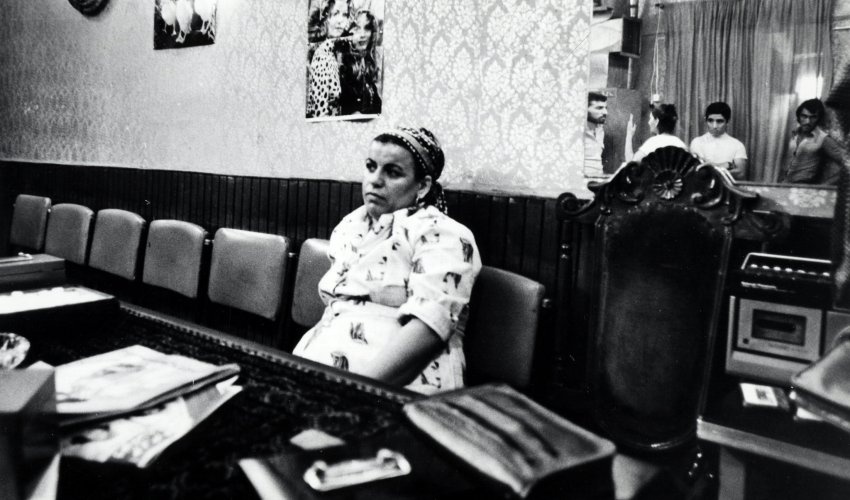Rare glimpses of Iran’s lost underworld - Photos

(NYT) - Kaveh Golestan was 52 on the bright spring day he died. He was killed in a minefield in northern Iraq in 2003 while working as a cameraman with the BBC.
Many journalists who encountered Mr. Golestan over his long career (including me) knew him as a hard-news photographer and cameraman. He was one of the finest chroniclers of the 1979 Islamic revolution that overthrew the shah of Iran, his native country; the nearly eight-year Iran-Iraq war; and Saddam Hussein’s gassing of the Kurds. His photographs of the revolution won him the Robert Capa Gold Medal.
What is less known is that in the years before the revolution, when Iran was still a Westernized monarchy, Mr. Golestan recorded in stark black-and-white the daily lives of Iran’s dispossessed. An exhibition of one of his most dramatic subjects — prostitutes confined to Tehran’s red-light district known as the Citadel of Shahr-e No (New City) — opens in the Foam Photography Museum in Amsterdam on Thursday and runs through May 4. The complete collection of 61 images will appear as part of a larger photographic, painting and film exhibition on Iran entitled “Unedited History: Iran 1960-2014,” at the Musée d’Art Moderne in Paris from May 16 to Aug. 24.
The Citadel was an old neighborhood of filthy alleyways in Tehran that was established in the 1920s as a red-light district to house scores of prostitutes. In the 1930s and 1940s, the neighborhood became a thriving sex quarter with rampant crime. Female prostitutes walked the streets seminaked. One of the side streets became famous for its young male prostitutes.
After the 1953 C.I.A.-led coup that reinstated the shah, the authorities walled off the area, turning it into a ghetto whose inhabitants were almost exclusively female prostitutes and their children; only men were allowed to access it through an iron gate.
By the 1970s, about 1,500 prostitutes worked, and most of them lived, in the Citadel. Their daughters often followed them into prostitution; their sons often turned to drugs. Sometimes men came for sex, sometimes to drink, do drugs, watch films or sightsee.
In the ghetto, there was a health center, a police station, a social-work office and a crude education service that taught basic reading and writing to women and their children. But the women suffered — from poverty, violence, heroin addiction, syphilis and destitution when they became too old to work.
Mr. Golestan’s work is the only existing photographic document of the Citadel. It first appeared as three photo essays in the daily Ayandegan newspaper in 1977; some of the photographs were included in a book of his photographs on Iran (“Kaveh Golestan 1950-2003: Recording the Truth in Iran”) published after his death. In 1978, the photographs were exhibited for 14 days at the University of Tehran, before the show was abruptly shut down without explanation. Later that year, they were briefly displayed in an underground exhibition at the Tehran Art fair.
The Amsterdam exhibition includes 45 images and is the first time the same original vintage prints have been shown together since then.
Mr. Golestan took notes on everything he photographed, and alongside the photographs, the exhibition will include excerpts from his diaries, newspaper clippings and audio interviews that he conducted in and about the area. The Citadel, he wrote, “confines some of Tehran’s prostitutes within its walls, like a detention center with a tight beehive of tiny cells.” He added, “The lives of the residents have plummeted to the lowest depths of human existence.”
He forged friendships with many of the women, photographing them regularly between 1975 and 1977. His images capture their degradation and despair: one woman with ample breasts visible in a low-cut polka-dot dress covers her eyes with one hand; one girl in a black dress with a white Peter-Pan collar and puffy sleeves looks as if she is no older than 14; another woman covers her head and upper body with a veil, but reveals her bare legs.
Ceilings leak; carpets are torn; mattresses are threadbare; plaster and paint are peeling. The place looks as if it smells of rot.
s the revolution unfolded, radical mobs attacked and set fire to sites they considered symbols of decadence, including the Citadel neighborhood. Most of the women are believed to have escaped, but there was no official investigation and no official count of the casualties. Some of the women were imprisoned and executed by firing squads; others were arrested and “reformed” according to Islamic revolutionary principles. The Citadel site was bulldozed as an act of cultural cleansing and in its place a park with a lake was built.
“You look at these photos and these women are looking right back at you and you have the feeling you are quite intimate with them,” said Kim Knoppers, the curator of the exhibition at Foam. “You forget the sense of time and place. The photos become universal images, which resonates in Amsterdam. We are so well-known for our own red-light district.”
Mr. Golestan’s original prints remained in his archive in Iran until about two years ago. Vali Mahlouji, a London-based Iranian curator and a distant cousin of Mr. Golestan’s widow, Hengameh, who is also a photographer, sought them out to create a complete archive of Mr. Golestan’s work.
The exhibition is the first part of his new project “Archaeology of the Final Decade,” which documents the cultural life of Iran in the years before the 1979 revolution. He intends to expand it into a nonprofit foundation to revive Iran’s historical and cultural material that was destroyed, banned or underrepresented in the Islamic Republic. He has opened discussions with museums and galleries in the United States to take the Golestan show there.
“The mission is to bring back and put into circulation artistic work that went underground because of the revolution and the policies that followed,” said Mr. Mahlouji in a telephone interview from London. “We want to create a link between where we were in Iran in the 1960s and 1970s and what happened after Iran’s cultural revolution of the 1980s. We’re starting by putting Kaveh on the artistic map.”
The content of Mr. Golestan’s exhibit might appeal to the authorities as it shows the “decadence” of the Old Regime; but it would have to be rejected because the women in the photographs have not covered their hair. (Despite the fact that prostitution in Iran’s Islamic Republic is illegal and punishments severe, the practice still flourishes.)
For colleagues and friends of Mr. Golestan, the exhibition is a fitting way to keep his spirit — and his art — alive. “He was driven by a social conscience and he always found a way to express it in his photography,” said Reza Deghati, the Iranian-French photojournalist and philanthropist who worked side-by-side with Mr. Golestan in Iran during the revolution. “His work is a real eye-opener.”
Mr. Deghati worked for Newsweek, Mr. Golestan for Time, but they often traveled together, and for long stretches were the only resident photographers working for American publications.
“I never had the sense there was competition between us,” Mr. Deghati said. “We were much too young for that.”
ANN.Az
Latest news 
More news 



































 Photo
Photo 



 Video
Video 

